Before you click out of this article thinking, “not another keyword research guide,” let me tell you something I’ve learned first-hand from working with national news publishers: Keyword research for publishers is entirely different.
The skills, processes, checklists, and tools you currently use won’t be as helpful in this niche.
Forget about presenting your list of keywords to an editorial team using the traditional keyword research method. Those keywords are already outdated!
Also, let me save you hours of time trawling through the thousands, if not millions, of keywords news sites naturally rank for.
SEO for news is different – and so is keyword research.
It’s about winning Top Stories optimization. This will get you the lion’s share of the daily search traffic for a news site.
The purpose of this guide is to equip you with a quick keyword research framework to teach to your journalists so they can win more of those Top Stories spots.
But first…
Why Is Keyword Research For News SEO Different?
Trending Topics
News websites require a different approach to keyword research than other types of websites.
They typically focus on timely, breaking stories that are often only relevant for a short period.
As a result, news sites need to quickly identify and rank for the keywords being searched for at any given moment (otherwise known as trending topic optimization).
Optimizing for trending topics requires a completely different approach to keyword research.
Traditional keyword research is generally based on 12 months of aggregated data, whereas news keyword research is predominately based on trending topics (which are topics that have not been searched before).
Data
Most local and national news sites cover multiple topics. If a story is of public interest, you can expect a publisher to cover it.
For example, around Christmas, you would expect most news sites to provide tips on festive cooking or buyer guides.
You would also expect these publishers to cover stories that capture the public interest, such as COVID-19.
And just like seasonal events such as Christmas, or worldwide events such as a pandemic, these topics go in and out of the mainstream public interest.
The difference is data; When you are looking at query data for a news site, you have seasonality and trend factors to consider. These factors may also be the reason why your traffic is either up or down.
But there is another factor.
Intent
When a topic is trending or newsworthy, Google gives news sites preference for this query. This is known as “query deserves freshness” (QDF);
“THE QDF solution revolves around determining whether a topic is “hot.” If news sites or blog posts are actively writing about a topic, the model figures that it is one for which users are more likely to want current information.”
For this reason, news sites can jump in and out of the search engine results page (SERP) for any query.
An easy example to explain this is to compare two U.S. presidents, one past and one present.
If we take the current president, Joe Biden, and compare that to George Bush, the 43rd U.S. president, we can see QDF in action.
For Joe Biden, both Top Stories are triggered at the top of the SERP, and news site topics are listed below.
-
 Screenshot from Ahrefs, November 2022
Screenshot from Ahrefs, November 2022
Whereas, if we observe the results for Bush, the SERP is mostly informational.
-
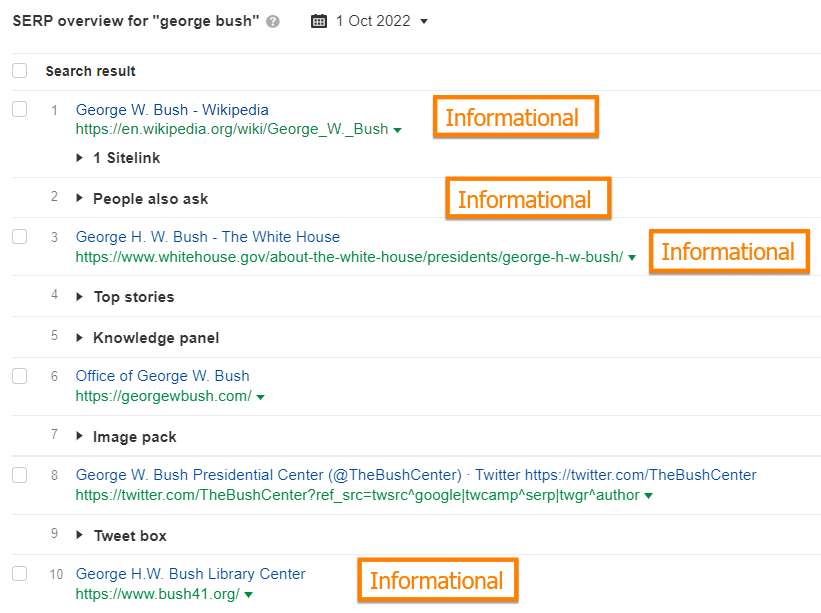 Screenshot from Ahrefs, November 2022
Screenshot from Ahrefs, November 2022Notice the lower placement of the top stories, also.
Entities
Keyword patterns for news sites are based on the five Ws of journalism: the who, what, when, where, and why.
They are the fundamental questions that any journalist should ask when covering a story.
- Who is involved?
- What happened?
- When did it happen?
- Where did it happen?
- Why did it happen?
Answering these questions in a story generally gives the journalist a good foundation.
To help journalists execute good on-page SEO with their headlines and subheadings, focus on the W’s and less on “keywords” as we know them as SEO pros.
Forget about explaining concepts such as keyword difficulty, monthly search volume, cost per click, or even impressions. Trust me, you will have lost them, and they will go back to ignoring SEO.
Detail
People forget that just because a story is online, it could also have been in the newspaper – and journalists need to tailor their work for both audiences.
In print, you can immediately take in all that is around the headline, such as all the pictures and subheads. In digital, there may just be a generic image and a headline.
Space is the real issue, since there is only so much space in a digital layout.
In print, shorter words that have an impact are key. And sometimes, that also relates to the number of lines in the headline.
But for SEO, this can hamper the reach of that story.
The key optimization tip you can give journalists is to have them include one of the five W’s in the headline.
And don’t be afraid about giving too many details away in the headline.
Here is a simple framework to use with a non-SEO journalist to help them understand keyword research.
Who Is The Story About?
People search for the name of the person, the place, or the thing.
Tip: Using the full name of the person, place or thing will perform better on the search.
Elon Musk will have more search volume than Musk.
Here’s an example:
-
 Screenshot from Ahrefs, November 2022
Screenshot from Ahrefs, November 2022
What Is The Story About?
To help search engines return our stories when people search for them, we need to tell both readers and search engines the facts of the story.
If this is about elections, then this needs to be in the headline.
Search engines are first-time users of your site every time; they can’t see the featured image the way a human can.
With SEO, if a headline does not contain the keyword or what the reader was searching for, search engines will be less likely to show the story in their search results.
Where?
Tip: Adding exactly where the news happened or is happening will help your story rank better.
People may be passing, briefly hear the news on the radio/TV, and will use their smartphones to find out what happened.
Sometimes, they might even just Google the location to find out the news. For example, “Ukraine.”
-
 Screenshot from search for [ukraine], November 2022
Screenshot from search for [ukraine], November 2022
It is less about keyword research and more about the elements of the story that people are searching for.
The Why?
When something happens in the news, people have questions – and a lot of people turn to search engines to help them answer their questions.
For example, in 2016, Britain voted to leave the EU; people searched for answers related to how it impacted them. i.e., “Why did Britain vote to leave the EU,” “What does Brexit mean,” “What impact will Brexit have on Businesses” etc.
Explaining the news is very effective for both SEO and generating new subscribers.
Breaking News Keyword Research
Breaking news is a term the media industry uses to describe real-time events or events that have just happened.
Breaking news can be something that has just happened in your local area or something that is happening in the world.
For the most part, the topic may have had little prior search interest. As a result, traditional keyword research tools are less helpful here.
Keyword research tools generally base their data on a 12-month average search volume.
For example, before COVID-19 became a worldwide pandemic, and pretty much every media outlet covered it, it was hardly ever searched.
-
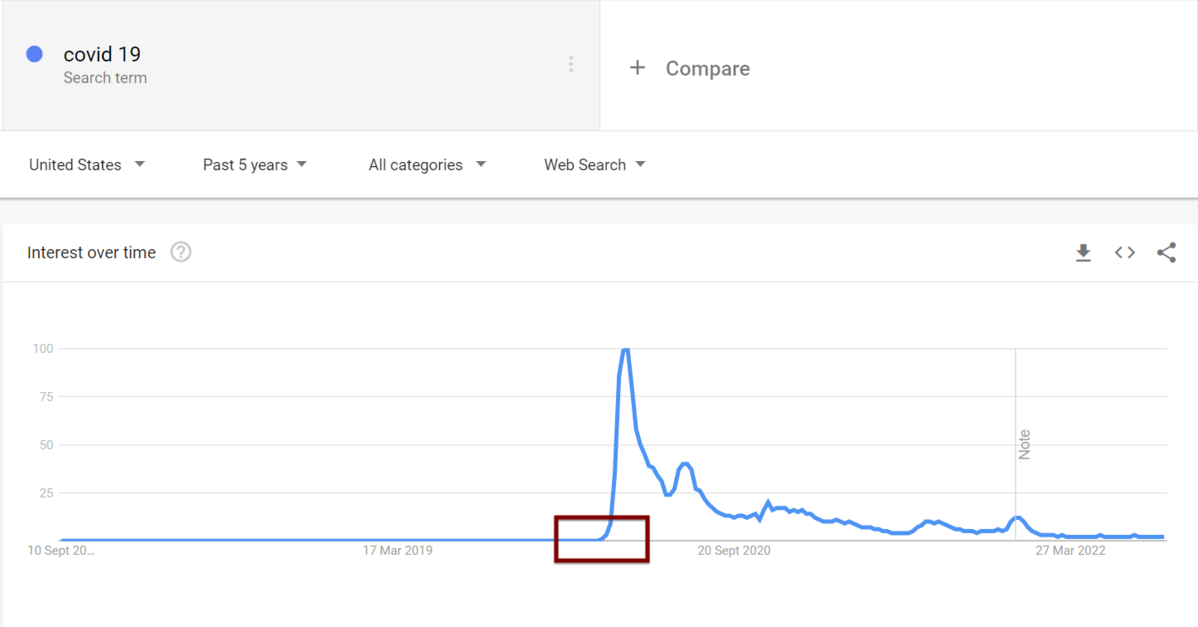 Screenshot from Google Trends, November 2022
Screenshot from Google Trends, November 2022
And prior to February 2020, if you had used your standard keyword research tools, searching for COVID-19 would have returned no data (or indicated that there was zero search volume).
Therefore, how do we do keyword research for breaking news when no data is available?
It’s simple: stop thinking about keywords the way you usually do. Instead, think of entities when doing keyword research for breaking news.
Focus On The Five Ws
To prove this methodology works, let’s use Google Trends for the top keywords around COVID-19 now that we have over a year’s worth of keyword data.
The top keyword for COVID-19 is, by no surprise: Covid 19.
-
 Screenshot from Ahrefs, November 2022
Screenshot from Ahrefs, November 2022
Even the third or fourth keywords, “Covid vaccine” or even “Covid 19 symptoms,” are also still answered by the question, “What is the story about?”
Tip: Keywords in the headlines are a very strong signal that Google uses to surface a news article in the top stories.
And don’t just take my word for it. Look what Google’s own documentation says:
“The most basic signal that information is relevant is when an article contains the same keywords as your search” referenced from Google’s guide on how it ranks news content.”
This is perhaps why a lot of news outlets have been directed by their SEO teams to use what is known as a kicker before their main editorial headline, i.e., {SEO Keyword}: {Editorial Headline}, as keywords closer to the start of the headline have a greater weight.
Using this approach can help a story rank high in the Top Stories. But this is not always the case.
Depending on the authority of the publication, including terms anywhere in the headline can also work.
When a story breaks, as mentioned several times throughout this guide, the most important keywords to cover are the five Ws.
The What, Who, And Where Components Of The Story
Unlike social, push alerts, and newsletters, where people are notified of the update, when people search, they are actively looking for information on a topic. This is especially true for breaking news.
A lot of the time, people hear about a story on another medium, such as the radio, TV, or even a colleague. They are given the bare facts of a story. But people have questions.
A lot of people, when they have questions, turn to search engines to get answers.
The best place to start researching keywords for breaking news is to open up Google Trends and use the first word that the story is about.
Google Trends
At the time of writing this – the topic “Typhoon Hinnamnor” was breaking news.
-
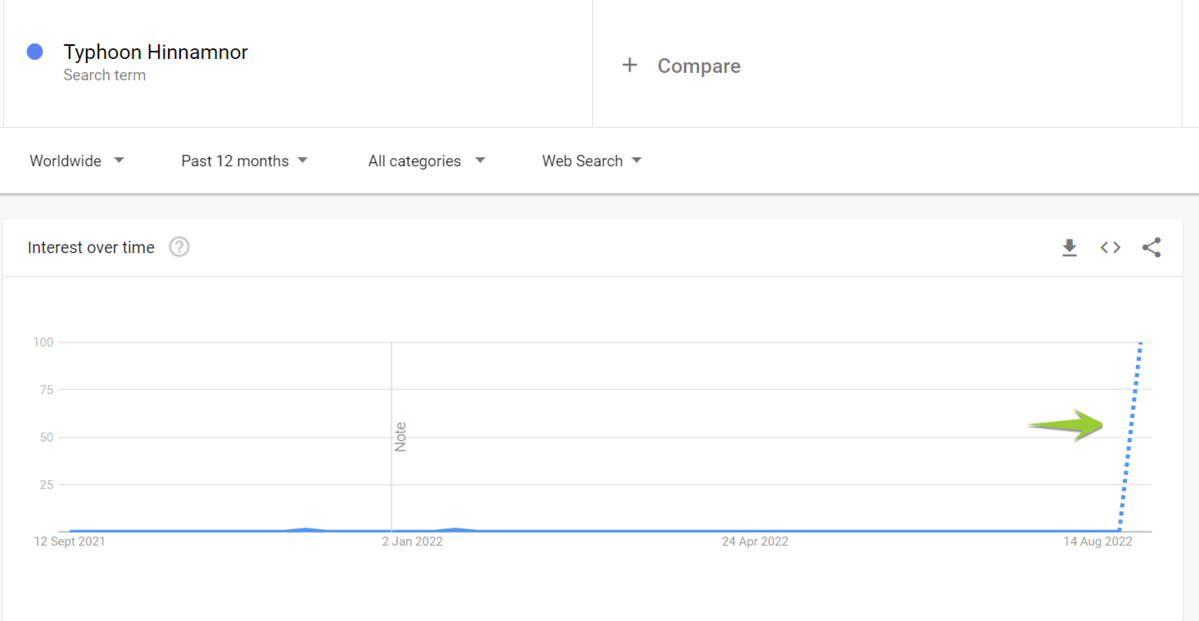 Screenshot from Google Trends, November 2022
Screenshot from Google Trends, November 2022
As you can see, prior to it being breaking news, there was relatively no search interest for the topic.
Ensuring that the keyword is used in the headline for any news updates on the topic is step one.
As we can see from the saved SERP below for “Typhoon Hinnamnor,” all of the publications are using the main keyword in the headline.
-
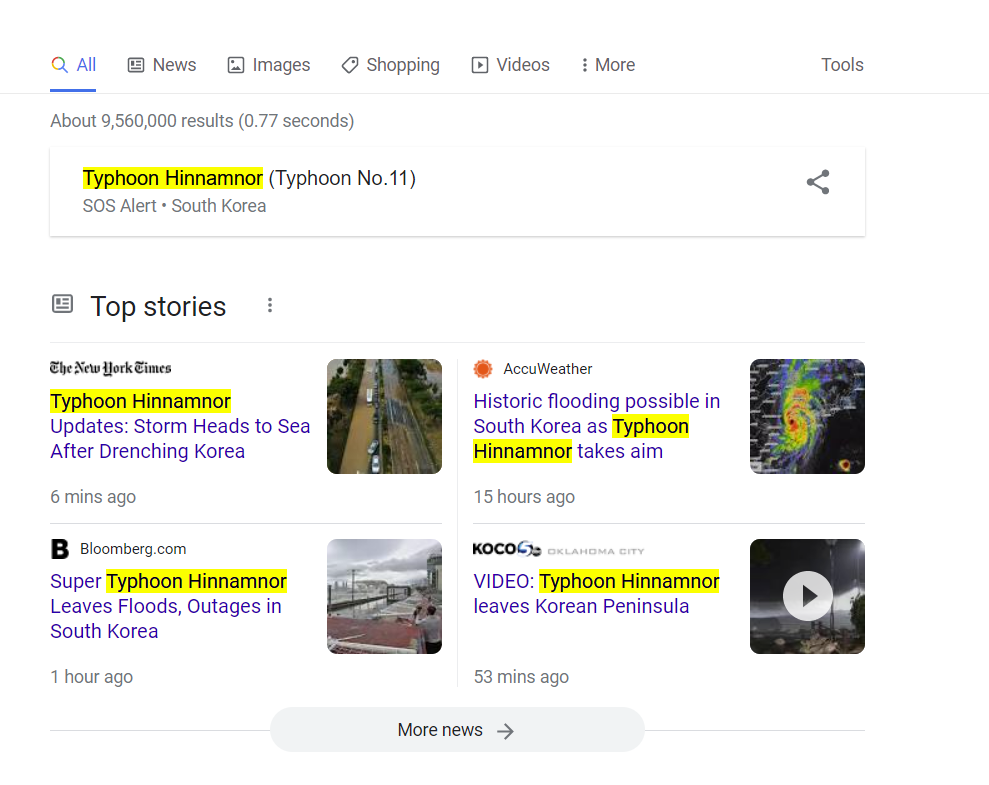 Screenshot from Google Search, November 2022
Screenshot from Google Search, November 2022
Tip: You can use – https://web.archive.org/save to save a search in time.
Very useful for capturing top story results, as when a topic is no longer news or publications are not covering a topic, the Top Stories carousel SERP feature will no longer show.
Let’s break this keyword down again using the formula above.
What Is The Story About?
The story is about a Typhoon.
Where Is The Story Taking Place?
Typhoon Hinnamnor in South Korea.
For the most part, people will be searching for coverage of the latest updates on a story – but as you can see above, Google has surfaced a video, meaning people are also searching for footage.
Once the latest news updates and video footage are covered, the next place to look is Google Trends.
Step 1: Type The Main Keyword Into Google Trends
-
 Screenshot from Google Trends, November 2022
Screenshot from Google Trends, November 2022
What you will see is that there are topics and queries that are breakout queries.
According to Google Trends, a breakout search term means it grew by more than 5000% in the requested time period.
Related queries give you an indication of what searches may also be looking for.
What you want to do here is take the related topics and search for their top terms.
For example, if we take the term “Typhoon” and filter by its top related queries, we can see that “What is a typhoon” is one of the top related queries.
-
 Screenshot from Google Trends, November 2022
Screenshot from Google Trends, November 2022
Note: Rising queries are the trending queries, and Top Queries are the most searched queries.
Step 2: Use Google’s Related Searches
The next step is to type in the keyword and use Google’s related searches.
-
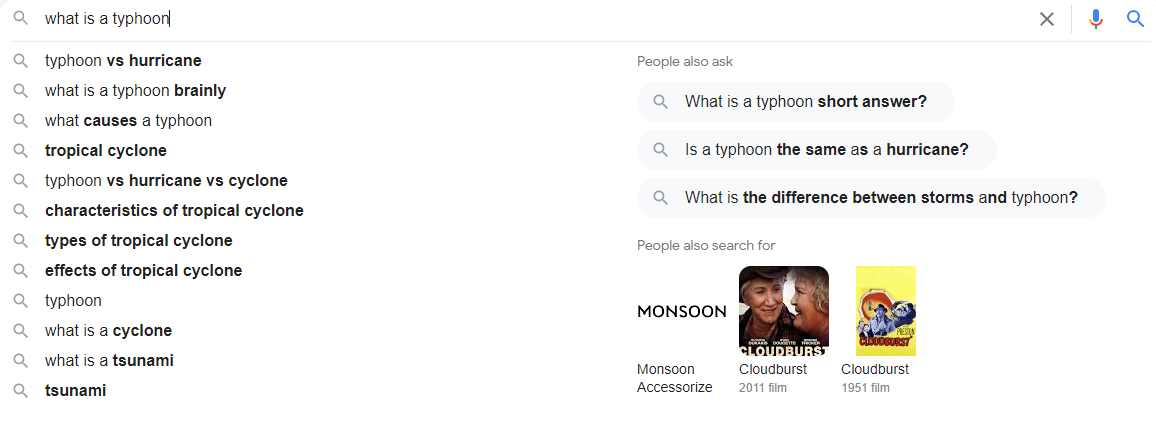 Screenshot from search for [what is a typhoon], November 2022
Screenshot from search for [what is a typhoon], November 2022
This can be a great place to discover related keywords and topics to include in an explainer piece around the news. These are also known as the “branches” of the story.
The main story is about the news on the Typhoon in Japan, but the branches are what people also want to know about now that they are aware of the news.
Tip: use an asterisk as a wildcard to represent a space that could be filled by anything. This will give you even more related questions to target.
For example “what are the effects of a typhoon” could be a great heading suggestion for an explainer of what a typhoon is.
-
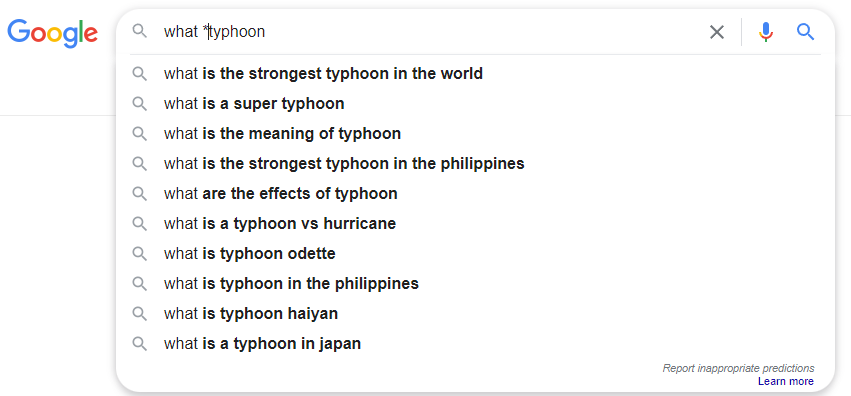 Screenshot from search for [what “typhoon”], November 2022
Screenshot from search for [what “typhoon”], November 2022
And if you want to do this research at a larger scale, freemium tools such as answerthepublic.com and alsoasked.com will help you here.
The addition of including these branches as part of an editorial workflow for live breaking news is that these explainers then turn evergreen.
Here is a great example of an evergreen explainer created by The New York Times that ranks for over 400 keywords related to the difference between typhoons, cyclones, and hurricanes that can be used whenever there is a related breaking news story.
-
 Screenshot from Ahrefs, November 2022
Screenshot from Ahrefs, November 2022
This is the magic formula when working with editorial teams.
It’s the secret to how you can get editorial teams to commission more evergreen content.
When a story is trending and newsworthy, supply them with the evergreen topic they also need to be writing – but framed as “this is what our search audience is looking for from our coverage on this news.”
The beauty about this workflow is that not only will this serve the purpose of the audience for the daily news agenda, as well as subscriber intent, but it is evergreen and can be updated as well as re-linked to when another hurricane or similar heavy weather topic enters the news agenda.
Now, apply this logic to seasonal events, such as Christmas, Easter, and summer. There are topics that will be published every year.
The key is timing and providing evergreen keyword topics when the subject is happening in the news agenda.
News Event Keyword Research
Google Trends is a great starting point when researching keywords for an upcoming news event.
Let’s take Black Friday as an example.
Step 1: Input The Target Keyword In Google Trends
-
 Screenshot from Google Trends, November 2022
Screenshot from Google Trends, November 2022
This gives us information about when this topic is predicted to trend based on the previous five years. Naturally, it spikes in November when Black Friday happens.
Step 2: Find The Related Keyword And Filter By Top
-
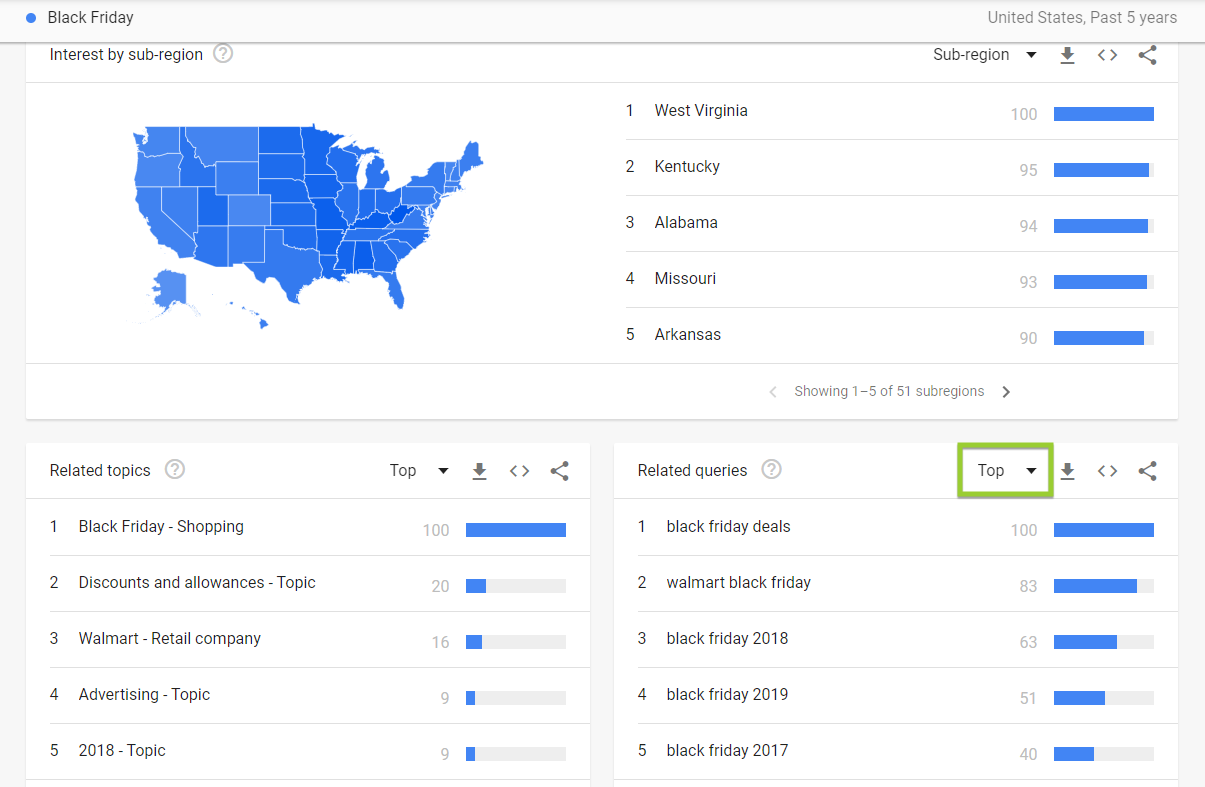 Screenshot from Google Trends, November 2022
Screenshot from Google Trends, November 2022
This will give you an idea of the top terms that people search for.
You will need to help your editorial team understand when and what to publish for search – not by looking at what keywords are trending at that current point in time, but by what was historically trending.
You can use Google Trends to give you this information.
And David Esteve, news media audience specialist, has put out the best Twitter thread on how to do this by the hour. According to David:
“Given that Google positively evaluates the proximity of the time your news is published relative to when there is a spike in search trends for that information, having a “predictive” knowledge of when those searches will start to occur, gives an extremely powerful advantage to the publisher who plans in this way.”
-
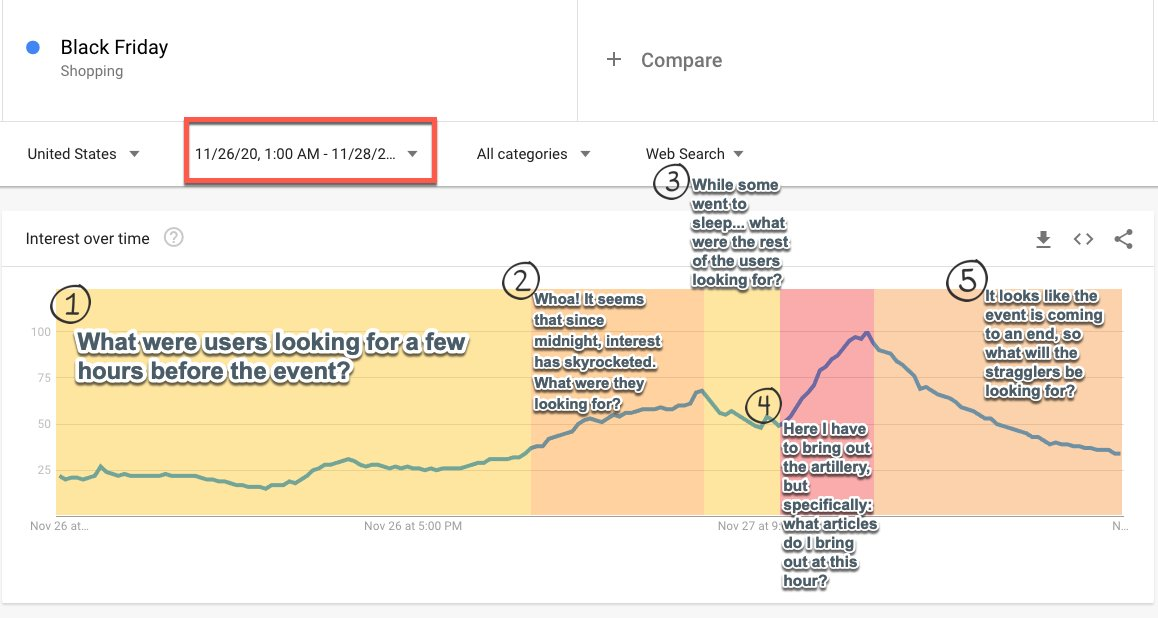 Screenshot from Twitter, November 2022
Screenshot from Twitter, November 2022
The key to getting this information for any topic is modifying the parameters of the default URL that Google Trends gives you.
For example, if we were to do this for Black Friday 2021, which was Friday, 26 November, we would need to amend the default URL that Google Trends gives us: https://trends.google.com/trends/explore?q=black%20friday&geo=US.
We are interested in Friday, 26 November 2021.
Therefore, step one is to use the date filter to get a customized date range, i.e., the 21st until the 27th.
-
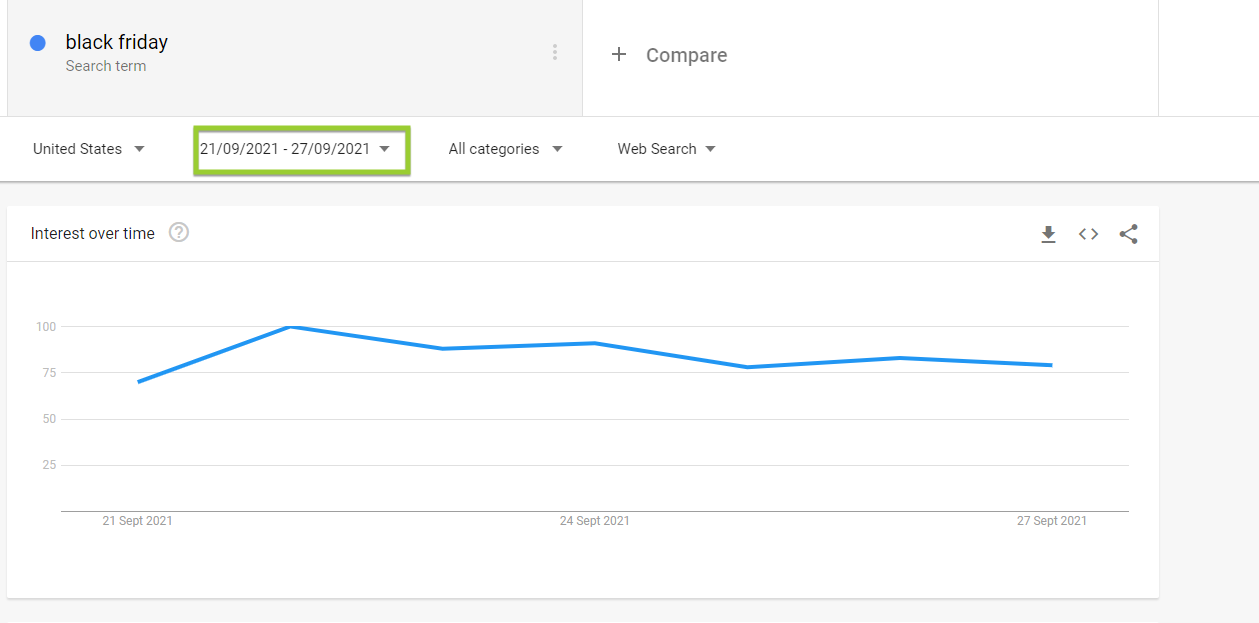 Screenshot from Google Trends, November 2022
Screenshot from Google Trends, November 2022
Now, if you look at the top queries, you get specific queries that searchers were looking for in that time frame:
-
 Screenshot from Google Trends, November 2022
Screenshot from Google Trends, November 2022
On the day of Black Friday, to decipher when and what to publish using David’s formula of adding the hourly data, i.e. https://trends.google.com/trends/explore?date=2021-09-26T00%202021-09-27T20&geo=US&q=black%20friday.
We can see that the morning had the peak search interest – meaning on the day of Black Friday, it would be important to let your editorial team publish as early as possible with the best deals and not wait for them to come in, as the search interest may die down the later the day progresses.
-
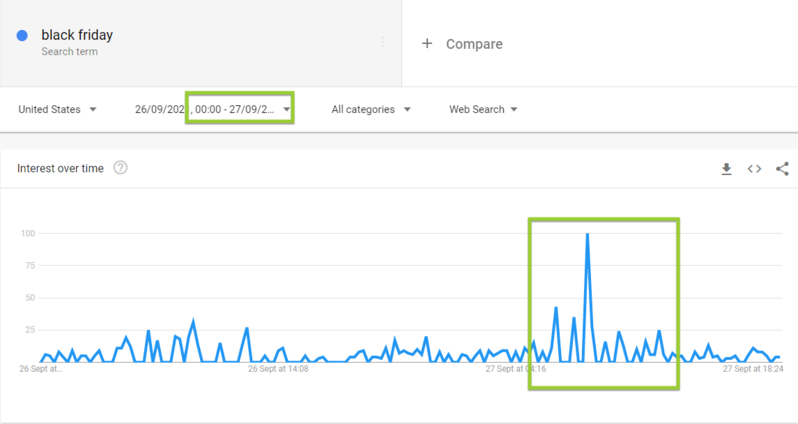 Screenshot from Google Trends, November 2022
Screenshot from Google Trends, November 2022
With news SEO and keyword research, what we are looking to accomplish is to inform editors about what the audience is searching for, but also when they are searching for it, to maximize the story’s reach.
As shown above, Google Trends is a really helpful tool to help inform editors of what people are searching for and when.
Key Takeaway
News sites traditionally rank for thousands, if not millions, of keywords.
There is no point in doing keyword research for news using traditional methods when topics haven’t been searched before.
Instead, focus on the five Ws, and teach journalists how to use these in headlines and on-page to maximize the SEO for news websites in the Top Stories carousel.
More resources:
Featured Image: Tero Vesalainen/Shutterstock
